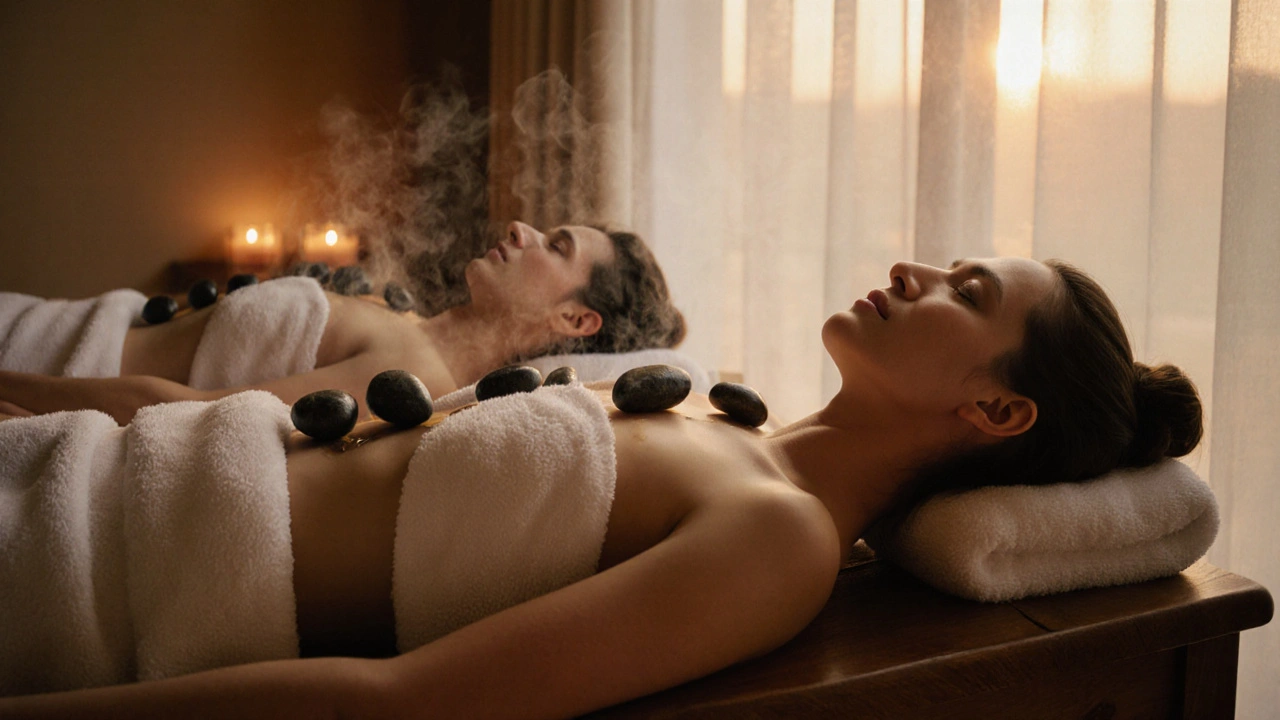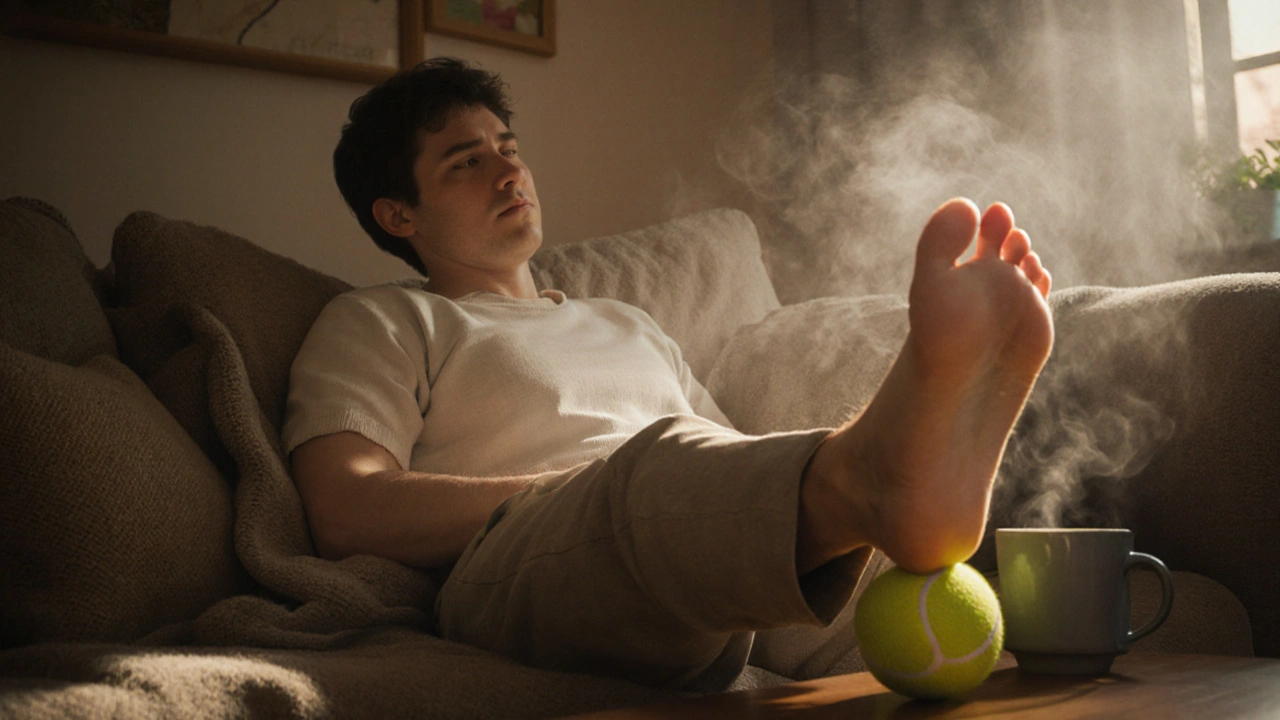Explore London's best head massage experiences, learn what sets them apart, discover benefits, types, costs, tips, and how to book your ultimate relaxation.

- Created by: Liam Redgate
- Completed on: 8 Nov 2025
- Categories: Couples Massage
What Makes Couples Massage Different?
You’ve probably had a massage before-maybe even a deep tissue session that left your shoulders screaming in relief. But a couples massage? That’s something else entirely. It’s not just two separate massages happening side by side. It’s a shared experience, a quiet moment where two people breathe together, move together, and let go together. No phones. No deadlines. Just touch, rhythm, and presence.
Think of it like this: when you hold hands in the dark, it’s not about the hand. It’s about the connection. A couples massage works the same way. It’s not just about easing muscle tension-it’s about rebuilding emotional threads that get frayed by work, stress, or just life getting in the way.
Why Try a Couples Massage?
Let’s be real: most of us don’t make time to truly unwind with our partner. We text. We scroll. We talk about bills or kids or who’s doing the laundry. But when was the last time you just sat quietly with them-no agenda, no solution needed-just being?
Studies show that physical touch releases oxytocin, the hormone linked to bonding and trust. A 2023 study from the University of Oxford found that couples who received synchronized massage sessions reported a 32% increase in feelings of closeness over four weeks. That’s not magic. That’s biology.
Here’s what you actually get:
- Lower cortisol levels (stress hormone)
- Better sleep after the session
- Improved communication-people talk more openly after shared relaxation
- A reset button for tension-filled relationships
And yes-it’s a great date night. No restaurant wait times. No awkward small talk. Just you, your partner, and a room full of calm.
Top 5 Couples Massage Techniques That Actually Work
Not all massages are built for two. Some techniques are designed for solo relief. But these five? They’re made for connection.
1. Synchronized Swedish Massage
This is the gateway drug of couples massage. Long, flowing strokes. Gentle pressure. Rhythmic movement. The key? You and your partner are massaged at the same time, by two therapists, using the same rhythm. It’s hypnotic. You’ll start breathing in sync without even realizing it.
Pro tip: Ask for warm oil-lavender or chamomile. The scent lingers, and it becomes part of the memory.
2. Partner-Assisted Shiatsu
This one’s for the DIY crowd. You don’t need a spa. You can do this at home. Shiatsu uses finger pressure on specific points along the body’s energy lines. Sit behind your partner. Place your thumbs on either side of their spine, just below the shoulder blades. Apply steady, slow pressure for 10 seconds. Then move down an inch. Repeat. It feels like someone’s untying knots you didn’t even know you had.
They do the same to you. No need to be perfect. Just be present.
3. Hot Stone Flow
Warm stones aren’t just for show. They sink into muscles, dilate blood vessels, and create a deep, melting sensation. In a couples setting, therapists place heated basalt stones along the spine, calves, and palms. Then they glide them slowly over the skin. The warmth doesn’t just relax-it tells your nervous system, ‘You’re safe.’
When both of you feel that heat at the same time, it creates a subtle, shared warmth that lingers long after the session ends.
4. Thai Stretch & Release
Forget lying still. Thai massage is active. Your partner gently guides your limbs through slow, yoga-like stretches while you relax. It’s like being folded and unfolded with care. You’ll feel your hips open, your shoulders loosen, your breath deepen.
It’s intense-but not painful. Think of it as a dance where one person leads, the other lets go. Switch roles halfway through. It builds trust.
5. Breath-Synchronized Massage
This is the quietest, most powerful technique. The therapist asks you to inhale deeply as they lift your arm, exhale as they release it. You and your partner mirror each other’s breath. The massage becomes a conversation without words. It’s not about pressure. It’s about rhythm. And when you finally open your eyes, you’ll realize you’ve both been holding your breath for longer than you thought.
What to Expect During Your First Couples Session
Walk into a good spa, and you’ll be greeted with soft lighting, quiet music, and the smell of eucalyptus. You’ll be shown to a shared room with two side-by-side tables. The room is warm, not hot. The sheets are clean, the towels thick.
You’ll both undress privately and cover yourselves with towels. The therapists will knock before entering. They’ll ask about pressure preferences. They’ll leave the room while you get settled.
Then-the music changes. Slower. Deeper. The first touch comes-gentle, warm, intentional. You feel your partner’s body relax beside you. You don’t need to look. You just know.
By the end, you’ll feel light. Not sleepy. Not numb. Light. Like you’ve shed something heavy.

How to Do a Couples Massage at Home (No Spa Required)
You don’t need to spend £150 to feel connected. Here’s a simple 30-minute routine you can do in your living room.
- Set the mood: dim the lights, light a candle, play ambient music (no lyrics).
- Use coconut or almond oil-warm it between your hands first.
- Start with the feet. Use your thumbs to press along the arch. Slow circles. Don’t rush.
- Move to the shoulders. Use the heel of your palm, not your fingers. Long strokes from neck to shoulder blade.
- Back: Have them lie face down. Use both hands in a wide, sweeping motion from spine out to the sides.
- Finish with hands. Gently pull each finger, one at a time. Then hold their hand for a full minute. Just hold it.
That’s it. No fancy moves. Just presence. And if you fall asleep halfway through? Perfect.
What to Avoid
Not every massage is right for every couple. Here’s what to skip:
- Deep tissue during pregnancy-too much pressure can trigger contractions
- Essential oils if either of you has sensitive skin or allergies
- Trying to fix each other’s problems during the session-this isn’t therapy hour
- Using your phone while your partner is massaging you
And don’t pressure your partner to ‘enjoy it more.’ Some people cry. Some stay quiet. Some laugh. All of it’s normal.
Couples Massage vs. Solo Massage: What’s the Real Difference?
| Aspect | Couples Massage | Solo Massage |
|---|---|---|
| Emotional Impact | Strengthens bond, builds trust | Relieves stress, improves sleep |
| Duration | 60-90 minutes (usually) | 30-60 minutes |
| Cost | £120-£200 for two | £60-£100 per person |
| Best For | Reconnecting, anniversaries, healing tension | Recovery, pain relief, self-care |
| After Effects | More conversation, longer calm | Immediate relaxation, but returns to routine faster |

Where to Find the Best Couples Massage in London
London’s got options. From hidden gems in Notting Hill to luxury retreats in Mayfair. Here’s what to look for:
- Spa at The Landmark London - Their couples suite has a private steam room and heated stone beds. Book the ‘Harmony Ritual’-it includes a shared herbal tea afterward.
- Body & Soul Spa (Notting Hill) - Smaller, intimate, and run by therapists who’ve trained in Thailand. They specialize in breath-synchronized sessions.
- Urban Retreat (Covent Garden) - Great for first-timers. They offer a ‘Couples Intro Package’ at £99 for 60 minutes.
Always check reviews for phrases like ‘felt connected’ or ‘therapists didn’t rush.’ That’s the sign of a real couples experience.
When to Book a Couples Massage
Don’t wait for a birthday or anniversary. Book it when:
- You’ve been arguing more than talking
- You’ve forgotten what their shoulders feel like without tension
- You both say ‘I’m tired’ but never mean it the same way
- You want to say ‘I love you’ without saying it out loud
There’s no perfect time. There’s only the moment you decide to try.
Frequently Asked Questions
Can we do a couples massage if we’re not romantic partners?
Absolutely. Couples massage isn’t just for lovers. Friends, siblings, or even parent-child pairs can benefit from the shared relaxation. Many spas offer ‘Connection Sessions’ designed for non-romantic pairs. The focus is on touch, calm, and mutual care-not romance.
Is it awkward to be naked with my partner during a massage?
Most people feel a little awkward at first. But here’s the secret: you’re covered with towels the whole time. Therapists are trained to respect privacy. You’ll only uncover the part being worked on. And once the massage starts, the focus shifts to sensation, not appearance. Most couples say the awkwardness fades within 10 minutes.
Can we bring our own music or scents?
Many spas let you choose the playlist or oil scent. If you’re doing it at home, go wild. Play your wedding song. Light a candle you both love. Make it personal. The goal is to create a space that feels like yours, not a generic spa.
How often should we do a couples massage?
Once a month is ideal for most couples. But if you’re going through a rough patch, try every two weeks. Even a 20-minute home session once a week can keep the connection alive. Think of it like brushing your teeth-small, regular care prevents bigger problems later.
Do we need to talk during the massage?
No. In fact, silence is often the most powerful part. But if you feel like whispering ‘thank you’ or ‘that feels good,’ go ahead. Some couples talk softly throughout. Others don’t speak until they’re back in the car. Both are fine. Let the touch do the talking.
Ready to Reconnect?
It’s easy to let life pull you apart. Work. Screens. Responsibilities. But the simplest things-touch, breath, quiet time-can bring you back together. You don’t need grand gestures. Just a room. A table. Two towels. And the willingness to be still.
Book that session. Try the home routine. Let your hands be your language. You’ll be surprised what happens when you stop doing things for each other-and just start being with each other.
Foot massage is a simple, science-backed way to reduce stress, improve sleep, and ease chronic pain. Discover how targeting just your feet can reset your entire nervous system and bring calm to your busy life.
Discover the best couples massage techniques to deepen connection, reduce stress, and rebuild intimacy. Learn how to do it at home or find top spas in London for a shared relaxation experience.



Buddy Latham
November 10, 2025 AT 10:59Johanna Iñiguez
November 12, 2025 AT 18:29Arlene Vanness
November 13, 2025 AT 04:05Ankit Chamaria
November 13, 2025 AT 22:00Oskar Banaszek
November 14, 2025 AT 17:39Gerald White
November 16, 2025 AT 14:41Kevin Puls
November 16, 2025 AT 21:36Travis Reeser
November 18, 2025 AT 12:30